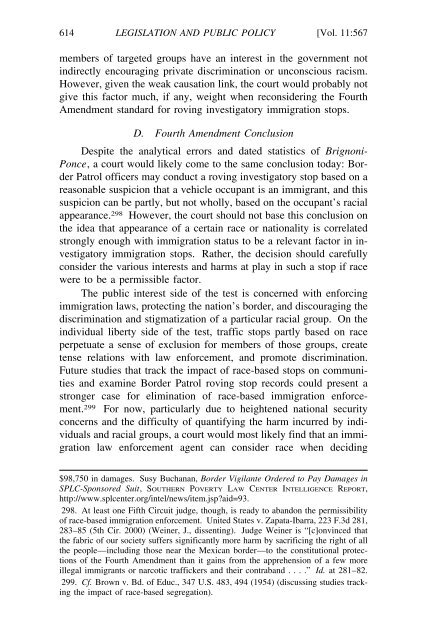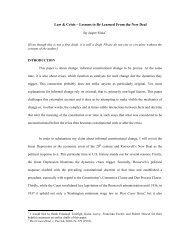updating brignoni-ponce - New York University School of Law
updating brignoni-ponce - New York University School of Law
updating brignoni-ponce - New York University School of Law
Create successful ePaper yourself
Turn your PDF publications into a flip-book with our unique Google optimized e-Paper software.
614 LEGISLATION AND PUBLIC POLICY [Vol. 11:567<br />
members <strong>of</strong> targeted groups have an interest in the government not<br />
indirectly encouraging private discrimination or unconscious racism.<br />
However, given the weak causation link, the court would probably not<br />
give this factor much, if any, weight when reconsidering the Fourth<br />
Amendment standard for roving investigatory immigration stops.<br />
D. Fourth Amendment Conclusion<br />
Despite the analytical errors and dated statistics <strong>of</strong> Brignoni-<br />
Ponce, a court would likely come to the same conclusion today: Border<br />
Patrol <strong>of</strong>ficers may conduct a roving investigatory stop based on a<br />
reasonable suspicion that a vehicle occupant is an immigrant, and this<br />
suspicion can be partly, but not wholly, based on the occupant’s racial<br />
appearance. 298 However, the court should not base this conclusion on<br />
the idea that appearance <strong>of</strong> a certain race or nationality is correlated<br />
strongly enough with immigration status to be a relevant factor in investigatory<br />
immigration stops. Rather, the decision should carefully<br />
consider the various interests and harms at play in such a stop if race<br />
were to be a permissible factor.<br />
The public interest side <strong>of</strong> the test is concerned with enforcing<br />
immigration laws, protecting the nation’s border, and discouraging the<br />
discrimination and stigmatization <strong>of</strong> a particular racial group. On the<br />
individual liberty side <strong>of</strong> the test, traffic stops partly based on race<br />
perpetuate a sense <strong>of</strong> exclusion for members <strong>of</strong> those groups, create<br />
tense relations with law enforcement, and promote discrimination.<br />
Future studies that track the impact <strong>of</strong> race-based stops on communities<br />
and examine Border Patrol roving stop records could present a<br />
stronger case for elimination <strong>of</strong> race-based immigration enforcement.<br />
299 For now, particularly due to heightened national security<br />
concerns and the difficulty <strong>of</strong> quantifying the harm incurred by individuals<br />
and racial groups, a court would most likely find that an immigration<br />
law enforcement agent can consider race when deciding<br />
$98,750 in damages. Susy Buchanan, Border Vigilante Ordered to Pay Damages in<br />
SPLC-Sponsored Suit, SOUTHERN POVERTY LAW CENTER INTELLIGENCE REPORT,<br />
http://www.splcenter.org/intel/news/item.jsp?aid=93.<br />
298. At least one Fifth Circuit judge, though, is ready to abandon the permissibility<br />
<strong>of</strong> race-based immigration enforcement. United States v. Zapata-Ibarra, 223 F.3d 281,<br />
283–85 (5th Cir. 2000) (Weiner, J., dissenting). Judge Weiner is “[c]onvinced that<br />
the fabric <strong>of</strong> our society suffers significantly more harm by sacrificing the right <strong>of</strong> all<br />
the people—including those near the Mexican border—to the constitutional protections<br />
<strong>of</strong> the Fourth Amendment than it gains from the apprehension <strong>of</strong> a few more<br />
illegal immigrants or narcotic traffickers and their contraband . . . .” Id. at 281–82.<br />
299. Cf. Brown v. Bd. <strong>of</strong> Educ., 347 U.S. 483, 494 (1954) (discussing studies tracking<br />
the impact <strong>of</strong> race-based segregation).
















